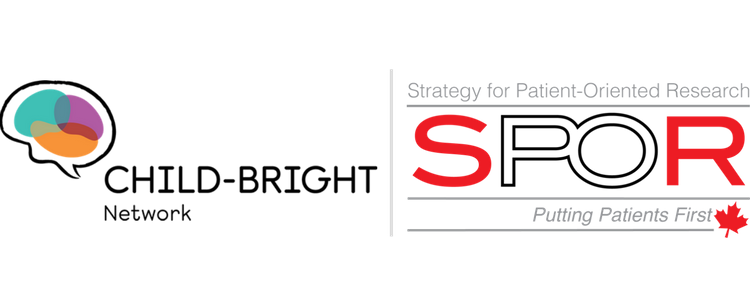As recently announced, the next phase of the CHILD-BRIGHT Network is being made possible thanks to a grant from the Canadian Institutes of Health Research (CIHR) under Canada’s Strategy for Patient-Oriented Research (SPOR), as well as matching funds from our generous partners. This support will allow us to grow from Network to Movement as we realize our mission for 2022-2026: moving our patient-oriented research into action through insight and methods grounded in implementation science and knowledge mobilization that embed the principles of equity, diversity, inclusion, decolonization and Indigenization.
In order to achieve this vision and become a movement for change for children and youth with brain-based developmental disabilities and their families, we have brought together experts from across Canada to lead our five patient-oriented programs.
For the past six years, our Citizen Engagement (CE) Program has monitored and enhanced citizen partnerships. In Phase 2, the CE team will continue to do so while assuming leadership nationally in promoting patient-oriented research in child health research and working closely with the EDI-DI Program to engage people who are underrepresented in the network. This important work will ensure that the rights of children with disabilities of diverse backgrounds and abilities are respected. Leading this work is Sharon McCarry, CHILD-BRIGHT’s Director of Citizen Engagement and Chair of the Citizen Engagement Council.
Sharon McCarry
CHILD-BRIGHT Director of Citizen Engagement
Chair, Citizen Engagement Council
We sat down with Sharon to learn more about the CE Program’s plans for Phase 2:
WHAT IS YOUR PROGRAM’S MANDATE?
Sharon McCarry: Citizens—children and youth, patients, parents, family members, caregivers, and health professionals—are at the heart of CHILD-BRIGHT. Our program aims to meaningfully engage people touched by brain-based developmental disabilities to guide the ongoing work of the network.
Since CHILD-BRIGHT’s beginnings, we have fostered meaningful engagement with youth and families, notably through the creation of our Citizen Engagement Council (CEC), composed of youth and young adults with brain-based developmental disabilities, parents of children with brain-based developmental disabilities, and other members, including researchers and health professionals. The CEC launched multiple measurement strategies to understand the engagement and partnership experiences of our network members. We created a Parent Liaison role to guide and support our parent-partners and spaces co-designed by and for youth with lived experience of brain-based developmental disabilities to be heard in research by developing our National Youth Advisory Panel.
HOW DO YOU PLAN TO ACCOMPLISH THIS? WHAT ARE THE MAIN TOOLS (CONCEPTS, FRAMEWORKS) THAT WILL BE USED TO FURTHER THIS MANDATE?
SM: As we build on our successes from the past six years, a big priority for CE will be engaging citizens from equity-deserving communities. We recently recruited new youth and we are also planning on leveraging current relationships with our members and the EDI-DI team to form new connections and build relationships with new organizations, community groups, and people living in rural environments.
In Phase 1, we developed several resources from lessons learned to enhance patient-oriented research. We will work with our project teams so they can incorporate these lessons at the start of their implementation science research projects, such as the tips that were developed out of responses to our stakeholder engagement study. These resources will also become part of a toolkit to support capacity building for investigators in child health research institutes and centres across Canada.
We’ll also collaborate with the Training & Capacity Building Program to train our members in new concepts that are key to our Phase 2 work, including implementation science, knowledge mobilization, and equity, diversity, inclusion, decolonization and Indigenization, so they can fully and confidently engage with our network.
TELL US MORE ABOUT YOU. WHAT MOTIVATED YOU TO TAKE ON THIS LEADERSHIP ROLE WITH CHILD-BRIGHT?
SM: I’ve been a passionate community advocate for families living with autism spectrum disorder and brain-based developmental disabilities since 2007 and I am committed to making meaningful and significant change in policies and services for the disability community. I initially joined CHILD-BRIGHT in 2018 as a parent-partner and member of the Strongest Families ND Parent Advisory Committee. Then, in 2021 I took on the role of Director of Citizen Engagement and Chair of the Citizen Engagement Council. I’m excited to be at the helm of the CE Program, working with our amazing CEC at such a pivotal time for the network, as focus turns to becoming a movement for change for children, youth and families.
WHY IS AUTHENTIC PATIENT-PARTNERSHIP SO IMPORTANT FOR RESEARCH?
SM: As a network falling under Canada’s Strategy for Patient-Oriented Research (SPOR), CHILD-BRIGHT has been at the forefront of a shift in health research. We are conducting research ‘with’ or ‘by’ patient, youth and family partners, as well as other network members, instead of ‘for’ them. This approach is intended to promote a better health system and better health outcomes.
In order to fully realize our mandate, and as we strive to align with the disability community’s mandate of “nothing about us without us”, it’s crucial that we create and maintain ever stronger connections with patients, youth, families, caregivers, and the community at large.
WHAT LEARNINGS FROM PHASE 1 WILL YOU BE LEVERAGING IN PHASE 2?
SM: We can learn a lot from our first round of onboarding network members. In Phase 2, we’ll be especially focused on clarifying roles and expectations for our patient-partners involved at the project, committee and network levels. We hope this will ensure early engagement of all our members in the research process. In Phase 1, we also developed compensation guidelines, which we will provide to patient, youth and family members involved in our research and network efforts right from the get-go.
Thanks to the three-part stakeholder engagement study conducted in Phase 1, we were able to gather a lot of valuable information that we can act on to enhance the engagement experience of our network.
For example, we learned about the need to develop relationships among patient, youth and family representatives and research team members in informal ways. Closed or smaller group conversations and coffee chats are great for this!
We’ll also emphasize effective and ongoing communication to clarify project goals and allow network members to stay actively involved. Regular check-ins with members during each phase of the research process will be a big part of that communication, as will offering accommodations and flexibility around people’s schedules and methods of participation in committee or project activities.
WHAT ARE YOU MOST EXCITED TO SEE IN PHASE 2?
SM: I’m most excited to see research culminate in changes to policy and practice for children, youth, and families with brain-based developmental disabilities! For the CE Program specifically, I’m looking forward to increased cross-collaboration between programs, looking at the terminology we use to ensure our language truly represents all our members, updating our compensation guidelines, and more. I’m optimistic about what our network can accomplish when we work together to bring about real change.
Thank you, Sharon, for this insight into the Citizen Engagement Program!
Consult the list of current opportunities to get involved with our network here. If you’re interested in participating in the Citizen Engagement Program, reach out to Citizen Engagement Coordinator/Project Manager Corinne Lalonde.










